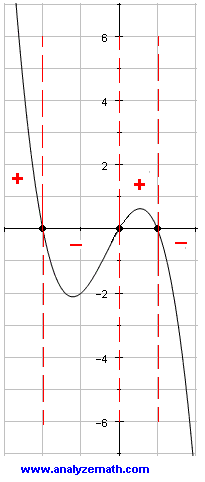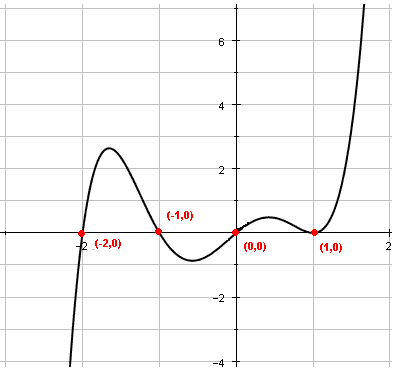Graphing Polynomials
Graph polynomials ; a step by step tutorial with examples and detailed solutions. Factoring, zeros and their multiplicities, intercepts and other properties are used to graph polynomials.
Examples with Detailed Solutions
Example 1
a) Factor polynomial \( P \) given by
\[
P (x) = - x^3 - x^2 + 2x
\]
b) Determine the multiplicity of each zero of \( P \).
c) Determine the sign chart of \( P \).
d) Graph polynomial \( P \) and label the x and y intercepts on the graph obtained.
Solution to Example 1
-
a) Factor \( P \) as follows:
\[
P(x) = -x^3 - x^2 + 2x
\]
\[
= -x(x^2 + x - 2)
\]
\[
= -x(x + 2)(x - 1)
\]
-
b) \( P \) has three zeros which are \( -2 \), \( 0 \), and \( 1 \), all with multiplicity one.
-
c) The three zeros of \( P \) split the number line into four intervals:
\[
(-\infty, -2), \quad (-2, 0), \quad (0, 1), \quad (1, +\infty)
\]
Select one value of \( x \) within each interval and evaluate \( P \) at that value to determine the sign of \( P \).
 \[
P(-3) = 12 > 0, \quad P(-1) = -2 < 0, \quad P\left(\frac{1}{2}\right) = \frac{5}{8} > 0, \quad P(2) = -8 < 0
\]
Using the signs of \( P \) in each interval, the sign chart is as follows:
\[
P(-3) = 12 > 0, \quad P(-1) = -2 < 0, \quad P\left(\frac{1}{2}\right) = \frac{5}{8} > 0, \quad P(2) = -8 < 0
\]
Using the signs of \( P \) in each interval, the sign chart is as follows:


Example 2
a) Factor polynomial P given by
\[
P (x) = x^4 - 2 x^2 + 1
\]
b) What is the multiplicity of each zero of \( P \)?
c) Determine the sign chart of \( P \).
d) Graph polynomial \( P \) and label the x and y intercepts on the graph obtained.
e) What is the range of polynomial \( P \)?
Solution to Example 2
- a) Factor \( P \) as follows
\[
P(x) = x^4 - 2x^2 + 1
\]
\[
= (x^2 - 1)^2
\]
\[
= ((x - 1)(x + 1))^2
\]
\[
= (x - 1)^2(x + 1)^2
\]
- b) Polynomial \( P \) has zeros at \( x = 1 \) and \( x = -1 \), both with multiplicity 2.
- c) Polynomial \( P(x) \) is a perfect square and therefore nonnegative for all real values of \( x \). \( P(x) \) is equal to zero at the two zeros \( -1 \) and \( 1 \), and positive everywhere else. The sign chart is as follows:

- d) The \( x \)-intercepts are at \( (-1, 0) \) and \( (1, 0) \), and the \( y \)-intercept is at \( (0, 1) \). The graph of \( P \) touches the \( x \)-axis at \( x = -1 \) and \( x = 1 \), and opens upward since \( P(x) \) is positive, cutting the \( y \)-axis at \( (0, 1) \). See graph below:

- e) Using the graph of \( P \) above, the range of \( P \) is given by the interval
\[
[0, +\infty)
\]
Example 3
a) Show that \( x = - 3 \) is a zero of polynomial P given by
\[
P (x) = x^4 + 5 x^3 + 5 x^2 - 5 x - 6
\]
b) Show that \( (x - 1) \) is a factor of \( P \).
c) Factor P and determine the multiplicity of each zero of \( P \).
d) Determine the sign chart of \( P \).
e) Graph polynomial P and label the x and y intercepts on the graph obtained.
Solution to Example 3
- a) Calculate \( P(-3) \)
\[
P(-3) = (-3)^4 + 5(-3)^3 + 5(-3)^2 - 5(-3) - 6 = 0
\]
Hence \(-3\) is a zero of \(P\), and \(x + 3\) is a factor of \(P(x)\).
- b) Since \(x + 3\) is a factor of \(P(x)\), the division of \(P(x)\) by \(x + 3\) must give a remainder equal to zero. Hence
\[
\frac{P(x)}{x + 3} = x^3 + 2x^2 - x - 2
\]
We now divide \(x^3 + 2x^2 - x - 2\) by \(x - 1\):
\[
\frac{x^3 + 2x^2 - x - 2}{x - 1} = x^2 + 3x + 2
\]
The remainder is 0, which proves that \(x - 1\) is a factor of \(x^3 + 2x^2 - x - 2\), and therefore also of \(P(x)\).
- c) Using the above, \(P(x)\) may be written as:
\[
P(x) = (x + 3)(x - 1)(x^2 + 3x + 2)
\]
We now factor the quadratic term \(x^2 + 3x + 2\) included in \(P(x)\). Hence:
\[
P(x) = (x + 3)(x - 1)(x + 1)(x + 2)
\]
\(P\) has zeros at \(x = -3\), \(-2\), \(-1\), and \(1\), and all are of multiplicity one.
- d) The sign chart is shown below:

- e) Using the information on the zeros and the sign chart, the graph of \(P\) is as shown below with \(x\)- and \(y\)-intercepts labeled.

Example 4
\( x = 1 \) is a zero of multiplicity \( 2 \) of polynomial \( P \) defined by
\[
P (x) = x^5 + x^4 - 3 x^3 - x^2 + 2 x.
\]
Construct a sign chart for \( P\) and graph it.
Solution to Example 4
If \( x = 1 \) is a zero of multiplicity 2, then \( (x - 1)^2 \) is a factor of \( P(x) \), and a division of \( P(x) \) by \( (x - 1)^2 \) yields a remainder equal to 0. Hence,
\[
\frac{P(x)}{(x - 1)^2} = \frac{x^5 + x^4 - 3x^3 - x^2 + 2x}{(x - 1)^2} = x^3 + 3x^2 + 2x
\]
Now, \( P(x) \) is factored as follows:
\[
P(x) = (x - 1)^2(x^3 + 3x^2 + 2x)
\]
\[
= x(x - 1)^2(x^2 + 3x + 2)
\]
\[
= x(x - 1)^2(x + 1)(x + 2)
\]
- \( P(x) \) has 4 zeros at \( x = -2, -1, 0, \) and \( 1 \), and the zero at \( x = 1 \) is of multiplicity 2.
- The sign chart is shown below:
 Use the sign chart and the zeros of \( P \) to graph \( P \) as shown below.
Use the sign chart and the zeros of \( P \) to graph \( P \) as shown below.

More References and Links to Graphing
Graphing Functions.











